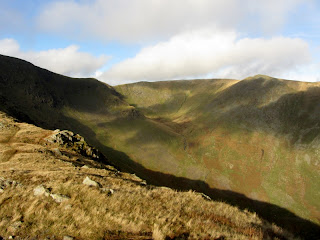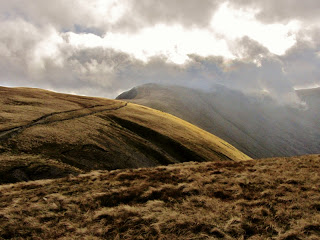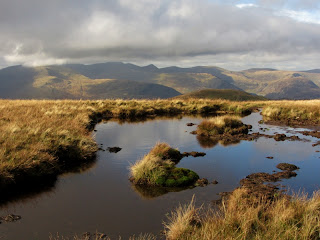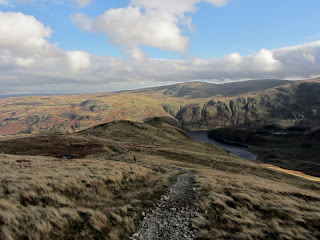Features.
The Montane Minimus is an ultra-lightweight waterproof jacket, weighing just 215 grams. It features a roll-away hood with volume adjuster and front drawcords, a water-resistant front zip with an internal storm-flap, hem drawcord adjusters, a mesh ventilated single chest pocket, some reflective piping and a small stuff sack. And not a lot else. It's available in bright red, vivid green (with red zips) and black.
Mesh-lined chest pocket is large enough to take a map.
Wired peak, adjustable drawcords that don't whip into the face when it's windy, internal storm-flap, velour-lined chin guard.
Why an ultra-lightweight waterproof?
For years, when going into the fells, the Fellwalk team have all dutifully stuffed waterproof jacket and trousers into our rucksacks, just in case the forecasters got it wrong; as we prefer to walk in decent weather, we tend to pick those days when the forecasters promise sunshine. And during many of our walks, the waterproofs stayed in the rucksack, making us grateful for the skill of our weather forecasters. The thing is, weighed together, a typical waterproof jacket and trousers combination can tip the scales at almost 1.5 kg - that's a lot of weight being needlessly carried on a warm summer's afternoon. It eventually dawned on us that we could enjoy our walks more, travelling further and faster, if we carried less. Yes, we're a bit slow on the uptake. We didn't want to ditch the waterproofs entirely, as the forecasters aren't always right, and so we started looking for an ultra-lightweight set of waterproofs for those days when it probably wouldn't rain, but might. Our criteria for the jacket were;
- weight of less than 250 grams
- wired hood with drawcord volume adjustment (we can't get along with those velcro-tab adjusters)
- hand pockets
- pit zips
- full-length front zip
- price of less than £100
A tall order! After several months of studying the options available, we could find no jacket that satisfied all the criteria: the closest we found was the Marmot Super Micah, which looked fine on everything except price, something we weren't prepared to compromise much on for a jacket that was to spend most of its days in the rucksack (hopefully). The Montane Minimus, however could be got for a price of around £100 (see the ad at the foot of the page), and satisfied most of the criteria. Also, the claimed breathability of the Pertex Shield fabric (25,000 MVTR - that's high, apparently) meant that maybe we wouldn't need those pit zips. And hand pockets wouldn't be much use in rain anyway, as the water would get in. So we chose the Minimus.
On test.
On its first couple of trips, the Minimus stayed in its stuff sack, apple-sized (a largish apple, but one that would easily compress down more) taking up little room in the bottom of a rucksack, and for this, and for the fact the rucksack seemed to be virtually weightless, we were exceedingly glad. Its first test came on the furthest reaches of the Kentmere horseshoe, traversing Thornthwaite Crag. The wind got up, large splodges of rain spattered down, and before long we were walking straight into driving sleet; had we known we'd be facing weather like this, we'd have packed the old, heavy, reassuring waterproofs. But we needn't have been concerned. The Minimus kept our tester completely dry, other than on the face - turning the face away from the wind helped; thankfully, the volume adjuster worked a treat and the hood remained firmly in place with any head movement. And the high breathability of the jacket surprised us, with no condensation inside at the end of the walk, despite the increase in temperature as we descended to the car. Who needs pit zips anyway?
Summary.
The Minimus has done everything asked of it so far, on day walks in the Lakes and North Wales. When it's been needed, it has kept the rain out; when it hasn't been needed, its weight hasn't been a burden in the bottom of the pack. It has all the features you need and nothing you don't, and has quickly become the waterproof jacket of choice for all hillwalks other than on the murkiest winter days. Despite our initial misgivings about its ability to keep the elements out (the material is so
thin) we wouldn't hesitate to pack it for extended, two- or three- (or more) day walks / treks. No doubt the fabric will wear quickly relative to the heavier, thicker fabric found on a more conventional jacket, but as the weather is
always going to remain dry on our future walks, maybe it won't get the chance!
Score: 9/10.
Pros:
- very light weight;
- excellent hood;
- highly breathable fabric.
Cons:
- We'd still like hand pockets, to help warm the hands on those drier days when we'll use the Mimimus as a wind jacket;
- How long will it last?
With an RRP of £140, the Minimus tends to retail at around £120. You can get yours for less than that, here:
The competition.
Other ultra-lightweights we considered are:
The North Face Triumph
Ultra-light, but a smock rather than a jacket, which limits its venting options. Also, we have misgivings about the floppy peaks on TNF's hoods - they don't stand up well to typically British blustery weather, tending to throw rain into your face when the breeze gets up. Quite expensive and difficult to find.
Marmot Super Micah
All the features we could want in a a lightweight waterproof, but it's quite pricey and hard to get hold of. We've also read some negative reports about the fabric, which isn't as breathable as that used in the Mimimus. On the plus side, the fabric is reinforced in places, to reduce wear from your rucksack.
Berghaus Elite half-zip
Very lightweight, but a smock rather than a jacket, again limiting venting options. Also, the fabric is not particularly breathable, so we imagine it would be uncomfortable on a muggy, wet day.
Go-Lite Malpais Trinity
Very light, full zip, hand pockets, available at discounted prices. we've read horror stories about the hood though, and the fabric isn't as breathable as that used on the Mimimus.


.jpg)










.jpg)

.jpg)
.jpg)
.jpg)
.jpg)
+(640x480).jpg)
.jpg)
.jpg)
.jpg)
.jpg)
.jpg)






